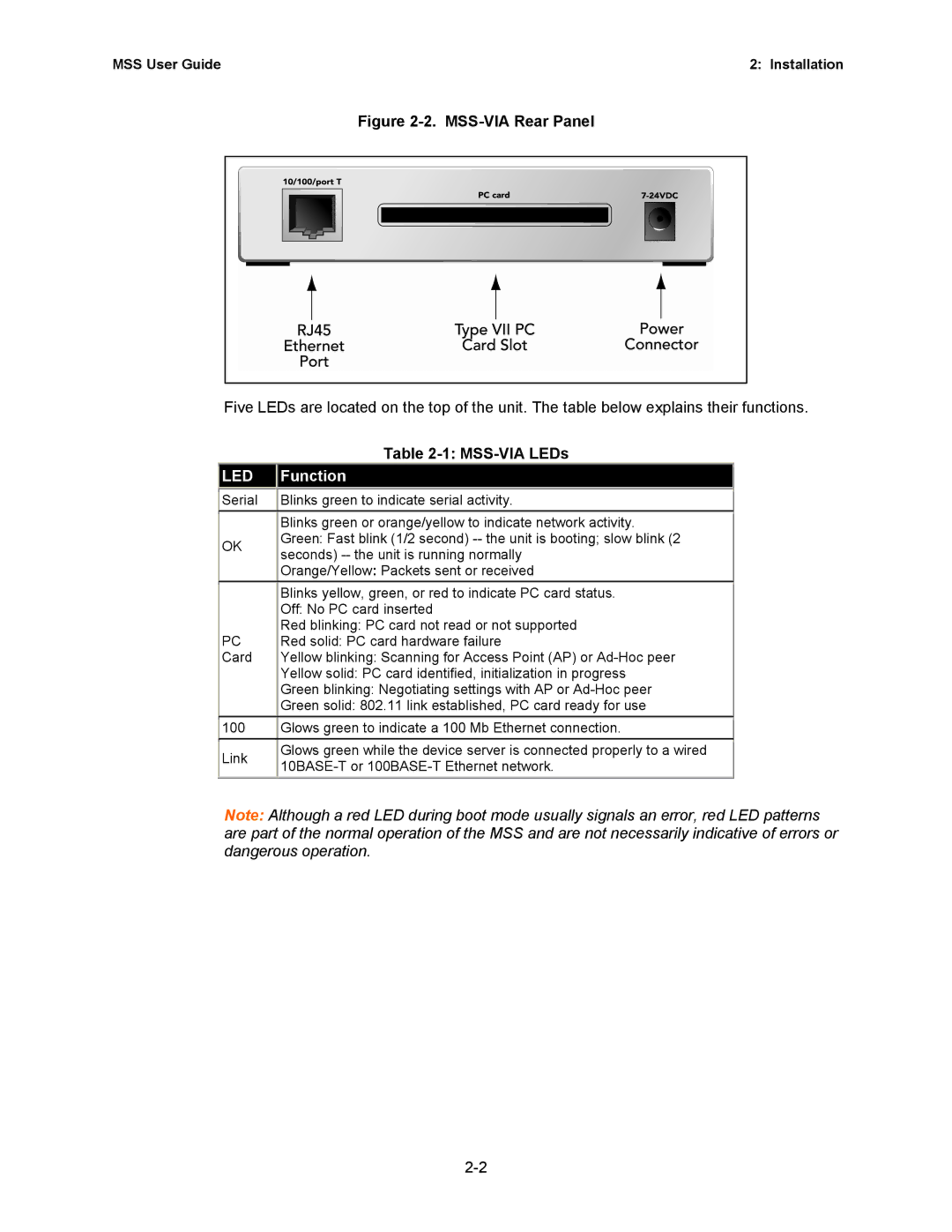MSS User Guide
Technical Support
Lantronix Corporate Headquarters
Sales Offices
Disclaimer & Revisions
Contents
Configuration
Using the MSS
Compliance and Warranty Information
Introduction to the MSS Family
MSS Family Features
Protocols
About The Documentation
Terms
MSS User Guide Introduction to the MSS Family
MSS-VIA Installation
Installation
Components
MSS-VIA LEDs
MSS-VIA Rear Panel
Example Wired Network Layout
Installation Procedure
MSS User Guide Installation
Pinging the MSS
Power power cube adaptor
MSS-VIA Specifications
Temperature
Humidity
MSS4 Components
MSS4 Installation
MSS Connected to a Serial Device and Network
MSS4 LEDs
MSS User Guide Installation
MSS4 Specifications
10 MSS100 Front Panel
MSS100 Installation
12 MSS Network Layout
MSS100 LEDs
13 MSS Connected to Serial Device and Ethernet
14 Pinging the MSS
MSS100 Specifications
Privileged User Status
Getting Started
Using EZWebCon
IP Address Configuration
Using a Web Browser
From the Action menu, select Assign IP Address
Entering ARP and Ping Unix
Using ARP and Ping
Using the Serial Console
Using a DHCP, BOOTP, or Rarp Reply
Login Password
Incoming Logins
Incoming TCP/IP Logins
Web Browser Login and Configuration
EZWebCon Login and Configuration
Serial Port Logins
Rlogin
Telnet
Remote Console Logins
Changing the Login Password
Incoming LAT Logins
Logout
Outbound Connections
Rebooting the MSS
Configuration
Normal Reboot
Overview
Factory Defaults
Protocol Configuration
TCP/IP Configuration
Name Server
Specifying a Gateway for MSS-VIA and MSS4
Supported Mibs
IP Security
Configuring Snmp
IPX NetWare Configuration
Snmp Trap Support
Routing and Encapsulation
Loadhost
Internal Network Number
Service Groups
LAT Configuration
Circuit Timer
Server Identification
Two-Wire Mode
RS-485 Configuration
22 Enabling Two-Wire RS-485 Mode for MSS4
Four-Wire Mode
Termination
TXDrive
Access Mode
Serial Port Configuration
Autostart
Serial Data
36 Configuring an Autostart Character for MSS-VIA and MSS4
Character Size, Parity, and Stop Bits
Baud Rate
Flow Control
Modems and Modem Signaling
Modem Control
Signal Checking
DSRLogout
DTRWait
Logouts
Preferred Host
Configuration
Dedicated Host
Region
Enabling 802.11 Networking
MAC Address
Extended Service Set ID Essid
Setting the WEP Key and Index Number
Network Mode
Channel
Modem Cards
Formatting an ATA Flash Card
Encrypted Traffic
Outgoing Calls
Incoming Calls
Incoming Connections
Using the MSS
Socket Connections
Outbound Connections
Interactive Connections
TCP/IP Socket Connections
Backward, Forward, and Switches
Break Key and Local Switch
Session Control
Disconnect and Resume
Status Displays
Session Limits
Show
Serial Tunnel
UDP Configuration
TCP Configuration
Enabling Multihost Mode
Multihost Mode
Adding Hosts
Modem Emulation Mode
Removing Hosts
17. Enabling Modem Mode for MSS100
Modem Mode Commands
Wiring Requirements
Sequential Hostlist Mode
COM Port Redirector
Power-up Troubleshooting
Troubleshooting
Power-up Problems and Error Messages
Bootp Troubleshooting
Dhcp Troubleshooting
Dhcp Troubleshooting
Bootp Troubleshooting
Tftp Troubleshooting
Rarp Troubleshooting
Modem Configuration Checklist
Rarp Troubleshooting
Change Bootp Enabled, Disabled
Entering Commands at the Boot Prompt
Init
Change Hardware
Change Dhcp Enabled, Disabled
Change Ipaddress ipaddress
Change Loadhost ipaddress
Technical Support Europe, Middle East, and Africa
Technical Support
MSS VIA Connectors
Ethernet Connector
Serial Connectors
Pinouts
RS-232 DB9 Connector
MSS4 Connectors
RS-485 DB9 Connectors
DB25 Connector
MSS100 Connectors
RS-232 DB9 Connectors
DSR Data Signal Ready versus CD Carrier Detect
Modem Wiring
DTR Data Terminal Ready
Obtaining Software
Updating Software
Reloading Software
Via the Web Via FTP
FTP
Flash ROM Troubleshooting
Troubleshooting Flash ROM Updates
NetWare
MSS User Guide Updating Software
Compliance Information
Compliance and Warranty Information
Warranty

![]()
![]() Glows green to indicate a 100 Mb Ethernet connection.
Glows green to indicate a 100 Mb Ethernet connection.